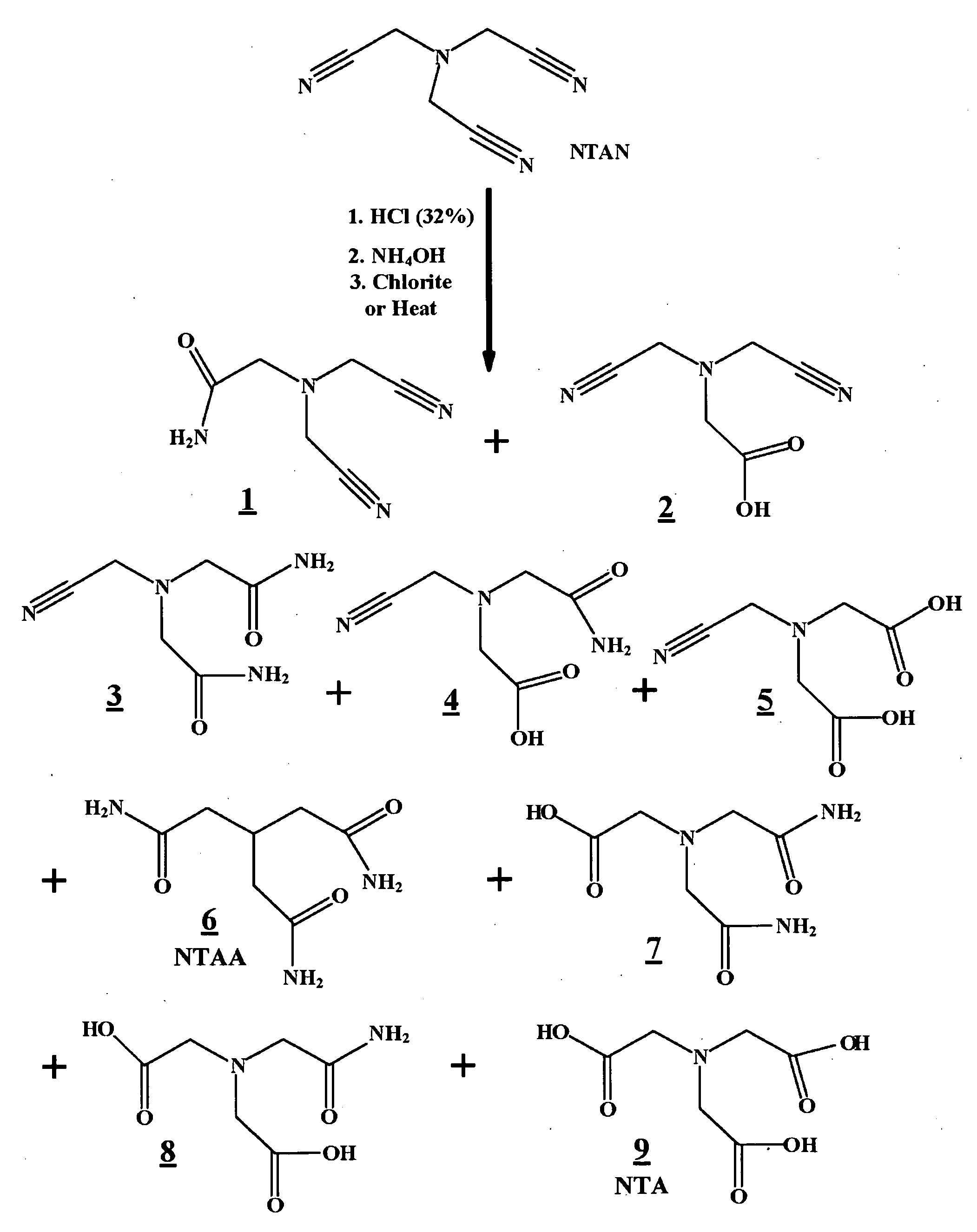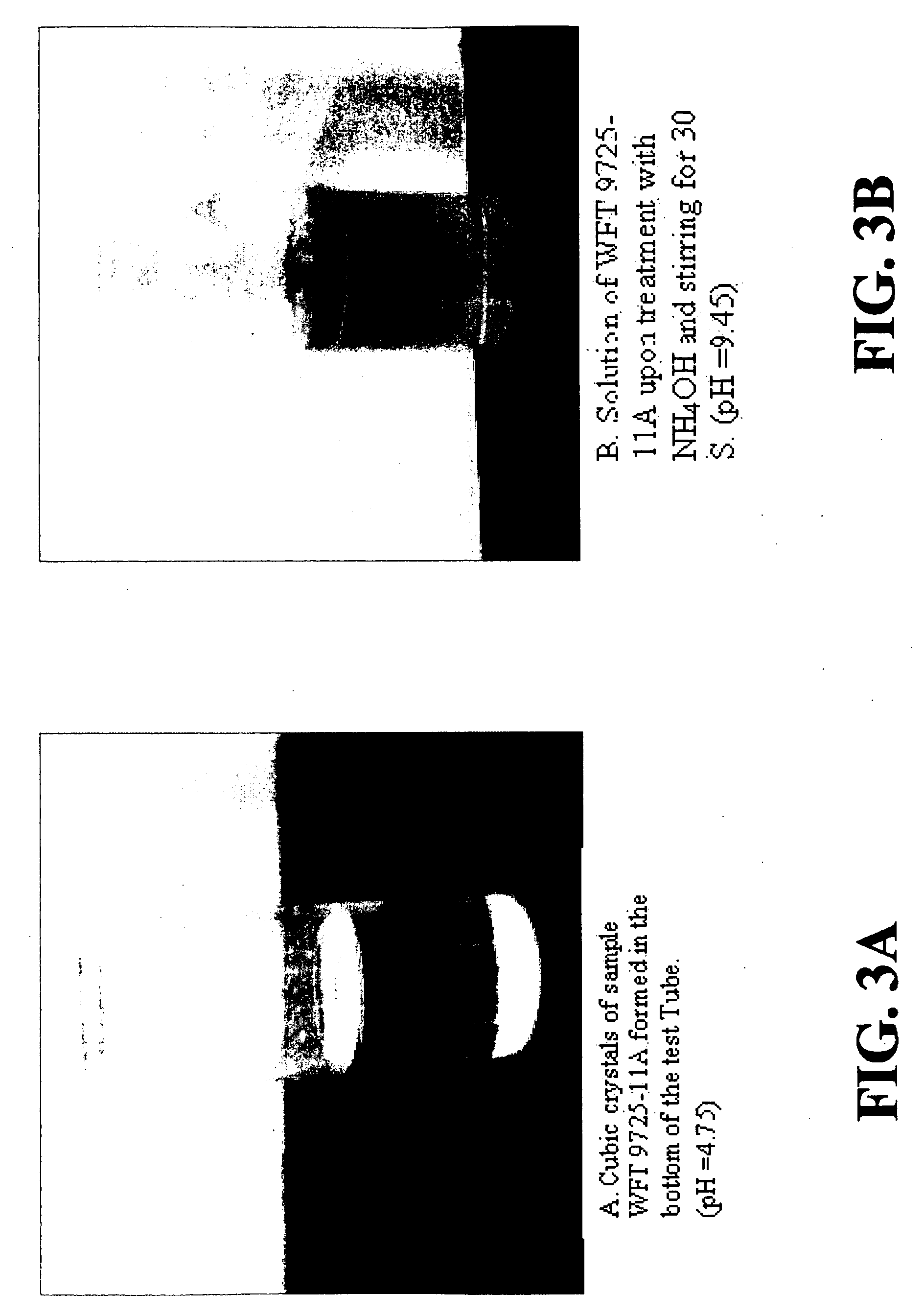Hydrolyzed nitrilotriacetonitrile compositions, nitrilotriacetonitrile hydrolysis formulations and methods for making and using same
a technology of nitrilotriacetonitrile and composition, which is applied in the direction of other chemical processes, organic chemistry, chemistry apparatus and processes, etc., can solve the problems of high toxicity of free cyanide to both human and ecosystem, sacrifice product performance and shelf life, etc., and achieve low free cyanide concentration, reduce, minimize, eliminate or destroy free cyanide
- Summary
- Abstract
- Description
- Claims
- Application Information
AI Technical Summary
Benefits of technology
Problems solved by technology
Method used
Image
Examples
example 1
Commercial Process
[0061]Hydrochloric acid (HCl, 32%, 200 g, 1.56 moles, 20 degree Baume) was placed in a 1,000 mL round bottom reaction flask equipped with a magnetic stirrer, a heating plate, a condenser, and an ice-bath. Nitrilotriacetonitrile (NTAN, 50 g, 0.37 moles), was added over 4 hours in 10% increments while stirring the resulting mixture and maintaining the temperature between 25-60° C. (77-140° F.). Then, the resultant white slurry was stirred for an additional 4 hour to permit complete hydrolysis.
[0062]Aqua ammonia (125 g, 29.4%, 26 degree Baume, 1.04 moles) was added to the mixture until a pale yellow color appears (pH=2.77), while maintaining the temperature below 60° C. (140° F.). The solution was diluted with deionized water (115 g, 5.70 moles) and the pH was adjusted to 5 by adding aqua ammonia to give 482.67 g of a product designated sample 3. [Note: The hydrolysis was incomplete because the last portion of NTAN was acid-treated for 1 hour of reaction following the...
example 2
One-Shot Addition of NTAN
[0063]The same procedure described above was followed, however NTAN was added in one shot to a HCl solution (using same reagent quantities), while stirring the resulting mixture vigorously. The reaction temperature rose gradually from 25° C. to 90° C. (77° F. to 194° F.) in 35 minutes giving a transparent light yellow solution. At about 90° C. (194° F.), the mixture refluxed gently. Solubility test showed complete hydrolysis of NTAN. The temperature then dropped steadily to 140° F. within 5 min. A portion (61.15 g) was withdrawn and treated with aqua ammonia (42.46 g, 26 degree Baume) and diluted with deionized water (20 g, DI) to dissolve suspended solids giving sample 14 (123.61 g, see FIG. 1). The remaining portion of the reaction mixture was refluxed for 1 h at 98° C. Similar work up produced 385.6 g of a product designated sample 15.
example 3
One-Time Addition of NTAN (Temperature Kept Under 140° F.)
[0064]Following the same procedure described in method A above, and using the same reagent quantities, NTAN was added in one shot to a HCl solution, while stirring the resulting mixture, and maintaining temperature between 25° C. (77° F.) and 60° C. (140° F.). The hydrolysis was complete in one hour.
[0065]Aqua ammonia (114 g, 29.4%, 0.9576) was added to the mixture, a pale yellow color appeared, while maintaining the temperature below 60° C. (140° F.). The solution was diluted with DI water (115 g) and the pH was adjusted to 5 by adding aqua ammonia (30 g, 0.86 moles) to give 504 g of a product designated sample 12. [The same procedure was repeated on a 100 g scale. Both temperature and reaction time were found to be the same.]
PUM
| Property | Measurement | Unit |
|---|---|---|
| Time | aaaaa | aaaaa |
| Bond length | aaaaa | aaaaa |
| Bond length | aaaaa | aaaaa |
Abstract
Description
Claims
Application Information
 Login to View More
Login to View More - R&D
- Intellectual Property
- Life Sciences
- Materials
- Tech Scout
- Unparalleled Data Quality
- Higher Quality Content
- 60% Fewer Hallucinations
Browse by: Latest US Patents, China's latest patents, Technical Efficacy Thesaurus, Application Domain, Technology Topic, Popular Technical Reports.
© 2025 PatSnap. All rights reserved.Legal|Privacy policy|Modern Slavery Act Transparency Statement|Sitemap|About US| Contact US: help@patsnap.com



